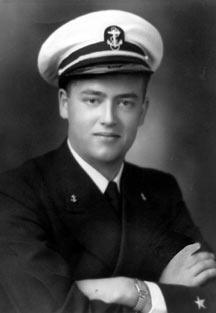
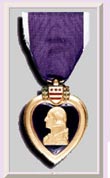
The PURPLE HEART is awarded to members of the armed forces of the U.S. who are wounded by an instrument of war in the hands of the enemy and posthumously to the next of kin in the name of those who are killed in action or die of wounds received in action. It is specifically a combat decoration.
William
Born: July 2, 1921
Died: January 4, 1945
Graduated Virginia Junior College on June 21, 1942
ENLISTED SERVICE
June 11, 1942 Enlisted in the US Naval Reserve
Aug 7, 1942 Rating changed to Aviation Cadet.
July 9, 1943 Enlistment terminated to accept appointment.
OFFICE SERVICE
July 10, 1943 Accepted appointment and executed oath of office as Ensign AV,
US Naval Reserve to rank from July 1, 1943 Reported to Naval Air Training
Center, Corpus Christi, Texas for temporary active duty involving flying.
July 10, 1943 Designated Naval Aviator.
July 10, 1943 Detached from Naval Air Training Center, Corpus Christi, Texas and to Naval Air Station, Miami, Florida for temporary duty involved flying under instruction.
Sept 7, 1943 Detached Naval Air Station, Miami, Florida and to Carrier Qualification Training Unit, Glenview, Illinois for further temporary duty flying under instruction.
Sept 12, 1943 Detached Carrier Qualifications Training Unit, Glenview, Illinois and to Naval Air Station, Jacksonville, Florida for temporary duty involving flying under instruction as Assistant landing Signal Officer.
Nov 3, 1943 Detached Naval Air Station, Jacksonville, Florida and to Naval Air Station, Sanford, Florida for temporary active duty involving flying under instruction.
Feb 8, 1944 Detached Naval Air Station, Sanford, Florida and to Fleet Air West Coast, San Diego, California for further assignment to duty involving flying as an Assistant Landing Signal Officer.
Feb 21, 1944, Ordered to Carrier Aircraft Service Unit 5 for temporary duty involved flying as an Assistant landing Signal Officer.
March 15, 1944 Detached Carrier Aircraft Services Unit 5 and to Fleet Air, Alameda Naval Air Station, Alameda, California for transportation to the USS Ommaney Bay, CVE-79.
March 18, 1944 Reported to the Ommaney Bay for duty involving flying as Assistant Landing Signal Officer.
Oct 1, 1944 Appointed Lieutenant (junior grade), US Naval Reserve for temporary service to rank from Oct 1, 1944.
Jan 4, 1945, USS Ommaney Bay is hit by Japanese plane.
Listed as Missing in Action on January 4, 1945 when his
ship, the USS Ommaney Bay was sunk in Mindoro, Philippines Islands in
the South Pacific. More on
the USS Ommaney Bay

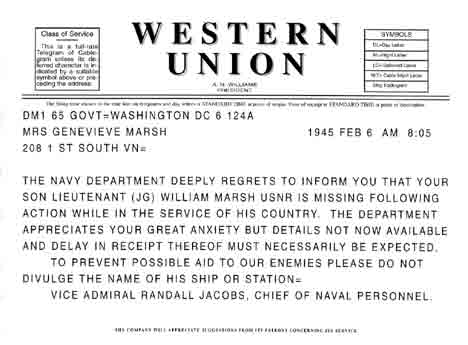
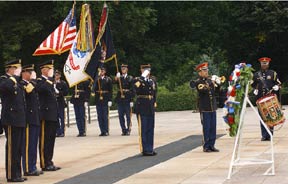
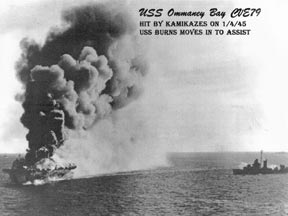
HONORING OUR VETERANS: Kamikaze survivors American Indian men share World
War II memories
By Dorreen Yellow Bird
Herald Staff Writer
When the Japanese kamikaze plane tore into the belly of the aircraft carrier
USS Ommaney Bay on Jan. 4, 1945, the strike was deadly. Two American Indian
men who survived the attack, friends from the Dakotas, would have those events
etched in their minds forever.
It was a sunny day, the elder Sidney Eagle Shield remembered. He was lookout on the sky port bow of the Ommaney Bay. When he glanced over his shoulder, he saw a plane coming out of the blue sky flying directly toward the carrier. Eagle Shield saw the plane hit the middle of the ship.
Solomon Sherman said he was just getting into bed after his watch on the same carrier when he heard a "big smack" and all the lights went out. They were down below and had to get up to the deck. There was confusion and panic, he said. Everybody was fighting to get up the same stairs. He found another set that the men had forgotten in the panic and climbed out.
There is a dwindling number of men left who remember World War II - 292,131 men were killed in the war that lasted from Dec. 7, 1941 to Dec. 31, 1946.
Eagle Shield, 85, grew up on the Standing Rock Indian Reservation that straddles the border of North Dakota and South Dakota. Today he lives with his wife, Minnie, in Little Eagle, S.D.
Sherman, 79, lives in Elderly Center at Fort Totten, N.D.
They were both drafted, but they had a choice of which branch of the service they would serve. Most of the men from Fort Totten and Turtle Mountain chose the Navy, Sherman said, so he also chose the Navy and that's why he ended up on the USS Ommaney that terrible day.
Abandon ship?
Topside, he said, everything was on fire - planes and the hangar deck.
"I didn't know which way to go to get to the flight deck. It was a terrible mess," Sherman said. They were waiting for the captain to say "abandon ship," he said.
"I remember the commanding officer finding us and he said we had to go back into the smoke and fire and see who was there."
There were torpedoes down in that fire and smoke, but they went below anyway, Sherman said. They were looking for sick bay and needed to check the engine room, but they couldn't get down there. It was all fire, so they turned around and returned to the hangar deck.
Than the captain said abandon ship, and "We jumped into the water," he said.
On the sky port bow, Eagle Shield looked over the ship's edge. He could see guys floating in the water. But he had to stay at his station until relieved. So he was really happy to see the lieutenant who told him to abandon ship.
He had to cross the burning ship and that wouldn't be an easy task. He had to get from the bow (the front of the ship) to the fantail (the back of the ship) to get in the water. The ship was burning and listing at the same time, he said. When he finally got to the fantail, there were five airmen trying to find a way to get down into the water without getting hurt. They found a big rope and they all climbed down into the water.
They swam in the water from about 3 p.m. that day until they were picked up by a destroyer at daybreak.
Meanwhile, Sherman said, he met other men in the water, and they formed a circle and stayed right there. Lifeboats were lowered from the ship and picked them up. Later they were transferred to the battleship USS Mississippi.
Back to battle
The suicide plane killed 95 men, but 600 survived the attack on the USS Ommaney Bay that day.
The USS Mississippi was headed for Lingayen Gulf in the Pacific. There they led and escorted Gen. Douglas MacArthur into a battle to retake islands in the Pacific, including the Philippines. The bombardment and shelling of the area had already started.
Sherman said they were below deck when they heard MacArthur had landed on the island.
Sherman's second ship, the USS Mississippi, was also hit by a Japanese kamikaze aircraft. It hit the gunner section of the ship and killed men there, but the ship didn't sink. The engine of the plane fell onto the deck of the ship, he said, and it looked so small to be so deadly.
Later he was transferred by merchant ship back to the United States.
For these two American Indian men, Veterans Day will always remind them of Jan. 4, 1945, when they survived the kamikaze attack on the USS Ommaney Bay.
--------------------------------------------------------------------------------
Reach Yellow Bird at (701) 780-1228 or dyellowbird@gfherald.com.
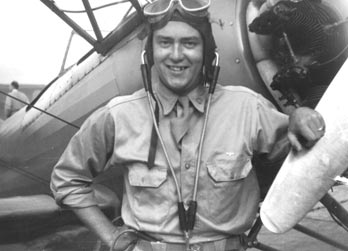
Slowly as the six F4F Wildcat fly back to the carrier USS Ommaney Bay, the boys on the deck can hear the planes engine before they begin to see the airplanes. The first plane makes a call to LTJG Bill Marsh and asks permission to land. The Air Boss slowly turns the big carrier into the air and checks the wind speed. On the deck of the Ommaney Bay are three people who must remain in sync when the six F4F Wildcats return, LT. Bill Marsh, the arresting cables officer (ACO) Richard Delaney and the guy the parks the planes, James Smuck. As each plane comes in for a landing, Bill Marsh must make sure that the arresting cables are set and that the flight deck is "clear" for landing. The first plane approaches the carrier and on the back left is Bill Marsh with his flags. His flags will tell the pilot if he is too high or low or to the left or right. Slowly you see this big plane with its engine-screaming coming in for a landing and caching one of four cables on the deck. If the pilot misses all four cables, he has enough power to make a go around. If the pilot does catch one of the cables, he shuts the power down and waits for Jim Smuck to tell him where to park. Then the process starts all over again as the remaining planes come in for landing.
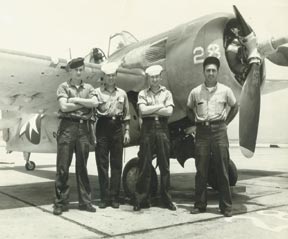
Lt. William Marsh's plane with his crew standing in front on the Ommaney
Bay flight deck. There is no date on this photo, but it must be from sometime
in 1944.
From left to right are:
Harold Erickson
Bernard Peterson
James Smuck (the same Smuck who wrote a letter to my grandmother Gen)
Marty Martinez
Gus and Charlotte Marsh attended the USS OMMANEY BAY Reunion on September 23-26, 2004in San Diego CA.
We arrived in San
Diego, CA on Thursday morning. After checking in, we boarded a bus for
a short ride to the USS Midway, an aircraft carriers from WWII. It was
not the same as the USS Ommaney Bay CVE79, but we all had a good time.
They had a SNJ trainer that was also on the Ommaney Bay. Also we saw A-46
Skyhawk, F-14 Tomcat, the LSO Platform, arrested landing and the catapult
shot. My Uncle William Marsh was a LSO on the Ommaney Bay.
For more info on the USS Midway, please go to Midway
The next day we loaded
a bus to Memorial Service at Fort Rosecrans National Cemetery, San Diego,
CA. After the Opening Sentences, Hymn, Invocation, Scripture Readings, Hymn,
I finally got to place the wreath on the memorial tribute. See the photo that
I attach.
Around noon we all went out for lunch at Tom Ham's Lighthouse Restaurant.
Boy did we have to climb stairs just to get something to eat.
Then the big surprise came on Friday afternoon. There was a guy on the Ommaney Bay, Ray Gensler who started to gather all the information from survivors, personal stories, ship logs, news articles and recollections back in 1984. In the early 1990's he stated to write the book on a typewriter, then someone told him about PC's and Macintosh. Well to make a long story short, in the 2004 reunion, we got our first chance to see the book. It was overwhelming. It is 550 pages of everything from the first day the keel was laid to the reunions up to 2003. His first printing was 235 and he sold 237 books. I purchased one and ordered two more books.
This was without a doubt, one of the best reunions that I have ever attended.
Gus Marsh
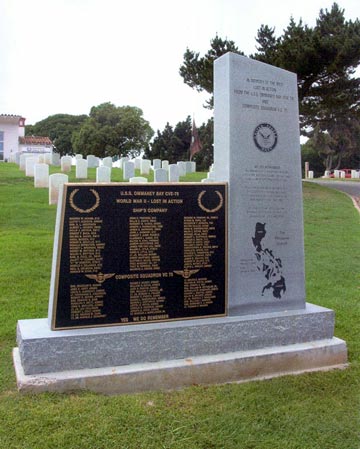
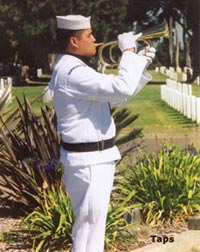
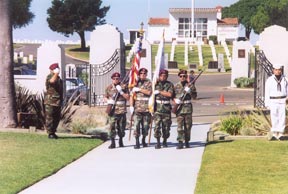
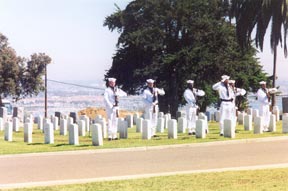
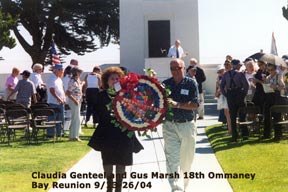
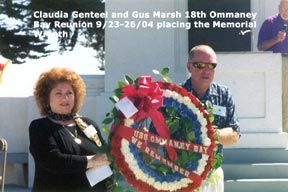
Claudia Genteel's brother died with my Uncle Bill on the Ommaney Bay when
it went down January 4, 1945. (Gus)
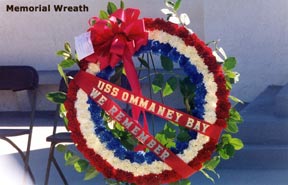
April 11, 1945
Dear Mrs. Marsh,
Your letter arrived a few days ago but I have been in Seattle so that's the reason for the delay in answering.
I knew Bill Marsh as I also worked on the flight deck and my job was to direct the airplanes after he got them on the deck. He also had taken me for a hop is a SBD dive bomber during our stay in Pearl Harbor and showed me the island.
I feel Bill may be on one of the Philippines as he was all right after the explosion and was helping one of my friends break out a fire hose. Then another fellow from Seattle was with Bill in the water and they were helping some other boys. He said Bill went over to help still another and after that he lost track of Bill. I don't want to build up your hopes too high, but many men have been found after ships sinking.
Sincerely, Jim Smuck
Letter written to Genevieve Marsh from Captain Young
My Dear Mrs. Marsh
It is my sad duty as Commanding Officer of the
U. S. S. Ommaney Bay to write you concerning your son, William Marsh, who
has been reported as missing in action during the enemy air attack
on and the sinking of the U. S. S. Ommany Bay in the Sulu Sea on 4 January
1945. I regret to inform you that after a careful survey of the facts there
is no further information.
It is believed that he was at his flight quarters station ready to signal
planes aboard if called upon. A Japanese air attack developed very suddenly
and bomb hits were made on the ship. Your son was
evidently hit by the blast and probably died instantly. A thorough search
was made inside the ship for any wounded survivors and these
men were transferred to other ships for treatment. Also, several destroyers
and small boats searched the waters for a considerable time after the ship
was abandoned in a effort to save all personnel.
Survivors have been checked very carefully but your son is not one of those
reported.
The Ommaney Bay took part in many actions against the enemy in the last six months and had one of the outstanding records of all the escort carriers. All of us were proud of our ccomplishments and I know your son contributed materially to the ship's success.
I wish that I could offer you more encouragement but there is only slight hope for his survival. I fully realize the inadequacy of anything that I can write to you tot lighten the burden of grief and anxiety which must be your at this time. I do hope that you may receive some comfort and courage in the knowledge of your son's brave devotion and splendid service.
Your son always could be relied upon to perform his duties and be a good shipmate. He was held in high esteem by all and was admired by his shipmates for his qualities of good fellowship and courage. He was a credit to his family and his country, and you may justly be very proud.
With my heartfelt sympathy, I am
Captain Howard L. Young, U. S. Navy
Letter to Genevieve Marsh from U.S. Navy Chaplain
My Dear Mrs. Marsh,
It has been my honored privilege to be the Chaplain of William Marsh, 298939,
Lieutenant (jg) U. S. N. R. missing in action. I wish it were possible for
me to clasp your hand and adequately express how my heart goes out to you
in this time of sadness. My most earnest prayer is that the God of all comfort
may fill your heart with His peace and
take away your loneliness by the reality of His gracious presence.
At the time of this Naval tragedy every effort was made to rescue the injured
and locate all hands, but some circumstances were unconquerable. At the scene,
I prayed for the dead and missing, commending them to our Heavenly Father.
A Catholic Chaplain who witnessed the events from a distance granted absolution
of sins to
Catholic men and read the Church burial service. I conducted a Protestant
Memorial Service at a later date. A Memorial Mass has been offered by a Chaplain
of that faith.
If there is any way in which I can help you, please do not hesitate to write me through the Bureau of Naval Personnel here in Washington, D. C.
May your hope and courage be strong through God's grace which is sufficient for every experience. To Him I commend you with tender sympathy.
Lieut. Arthur R. Anderson, Chaplain, U. S. Navy Reserve